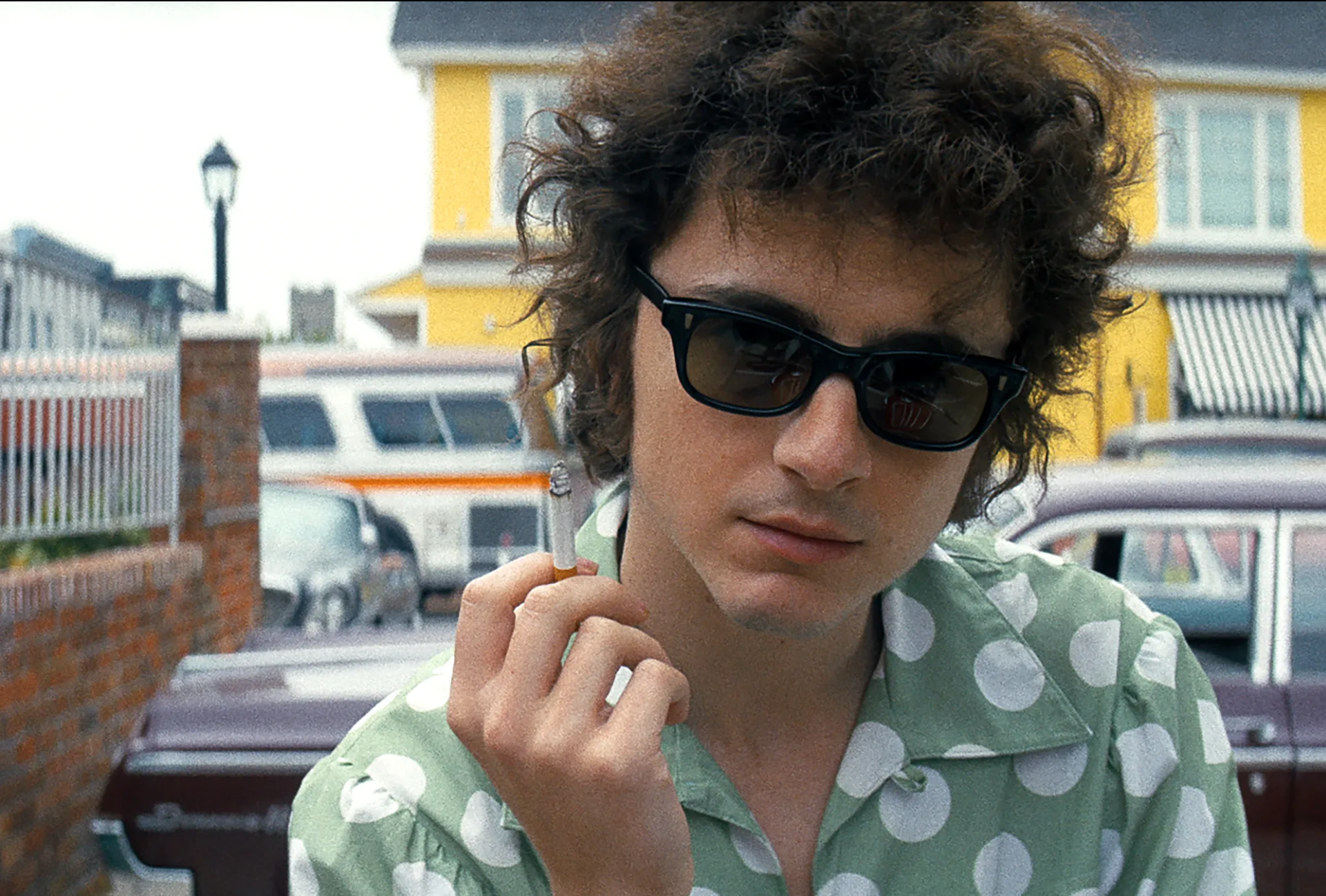Young Dylan rebels against the folk scene in this evocative, beautiful biopic

A Complete Unknown | dir. James Mangold | Reviewed by Joseph Hunter
Handsome, chiselled, lyrically-named Timotheé Chalamet looks like Bob Dylan in this film. I mean he really, really looks like Bob Dylan. The styling helps: the clothes, the sunglasses, the wigs. But there’s more to it than that. As physical transformations go it isn’t drastic. Especially given auteur-actors’ penchants for self-brutalisation. Christian Bale’s self-starvation for The Machinist comes to mind, as well as De Niro’s infamous bloat-up for Raging Bull. Still, from his first appearance in A Complete Unknown, as the young Robert Allan Zimmerman, a.k.a. Bob Dylan, Chalamet is even more baby-faced than ever. His cheeks are rounder, puffier. His eyes seem shadowed by a mysterious weight beyond his years. He is Dylan, to look at.
He sounds pretty good, too. An early scene has Dylan visit Woody Guthrie in hospital, where he also meets Pete Seeger. He plays ‘Song for Woody’ for them both, the audience’s first taste of Chalamet singing as Dylan. In this scene his voice is wonderful – mellifluously nasal, gentle, and lilting. In conversation he undersells the lines as a rule, but does so with a touching affectivity that is the more effective for being, self-consciously, half-suppressed.
Chalamet’s singing is, however, imperfect. But unlike the real-life Dylan, whose idiosyncratic singing was and is far from ‘perfect’ musically, Chalamet’s is sometimes imperfect in a way that simply doesn’t sell the music well. This becomes most apparent at about the point in the film that Joan Baez (Monica Barbaro) enters. Baez is already a star, and Barbaro’s vocal performance during a key scene in which she covers the microphone and sings acapella is sweet and unbroken, fine as quality china. In part this is a counterpoint to Dylan’s ‘sand and glue’ voice, but Chalamet’s singing is a let-down coming immediately afterwards. He is at his best during scenes which capture the stunning mundanity of the composition of timeless songs, for example working out the first drafts of ‘Girl from the North Country’ in a sunlit corner of Seeger’s kitchen, singing half under his breath. Then, too, his voice comes alive again when Dylan switches to electric later in the film and assembles his band around him. With the band’s kinetic, joyous sound underneath him his vocals are carried along.
Director James Mangold captures early 1960s Greenwich Village beautifully. The streets are sepia and worn, and in the indoor scenes the light is muted, church-like, the surfaces earthy and textured: wood, stone, scuffed cloth. Actor’s faces and hands are picked out in a dynamic chiaroscuro. There is a tactile quality about this diverse, bohemian place and time that feels just right. Context, political and otherwise, is skilfully drip-fed to us through snatches of news radio, or background action in street scenes.
The story of the film is that of Dylan’s rapid rise within, and disillusionment with, the mid-20th century American folk scene. That scene is humanised mainly through Pete Seeger, played with gentle heart by Edward Norton, who mentors the young Dylan and inevitably becomes somewhat of a disappointed father-figure by the time of the latter’s notorious electrified set to close out Newport Festival in 1965. Barbaro’s proud, confident Baez is an excellent counterpoint to the increasingly rebellious, sullen Dylan, telling him frankly after a late-night booty call at the Chelsea Hotel that he’s acting like an asshole.
The character of Sylvie Russo (Elle Fanning), a thinly-fictionalised depiction of Dylan’s girlfriend of the time Suze Rotolo (of The Freewheelin’ Bob Dylan album cover fame), lends added poignancy to the film’s final third. There’s a wonderful shot that closes slowly on Russo as she watches Dylan sing with Baez, her eyes filling with tears for a parting that must inevitably come. Dylan’s own parting with the folk scene, at the film’s climax, is played out with loving detail, and magnificent sound: live, alive, and liquid.
There is much to love in this film, and many times I found myself smiling in the dark of the Oldham Odeon. Some moments are uncanny (in the Freudian sense) in that they seem so much like the 1960s I was raised to believe in come to life again, and singing. And I know that this is a fiction, like all biopics are. The ‘Judas!’ heckle from Dylan’s 1966 set in Manchester is given to an audience member at Newport, for example. I know it only seems. But the songs feel alive, and so do the people. In the scene where Dylan plays Baez a new song he’s just written, ‘Blowin’ in the Wind’, sitting on his unmade bed, her standing in his grubby galley kitchen wearing one of his t-shirts, the uncanny unreality of it all threatened to overwhelm me. Chalamet doing his best Dylan voice, playing a song that we all know so well that we can hardly hear it as music anymore but more as a sort of force, or constellation of times, places, and energies, strums out the chords and is joined by Baez in an improvised duet on the bed, the morning after, in the sunlight. I wondered what it was all for. What it serves. The song? The real, flesh-and-blood people? The actors? Or does it serve us, aiming for that melange of nostalgia and sense of beauty that is love of music, and the mistaken hero-worship that goes along with it? I couldn’t answer those questions as I watched, and I can’t now. I only know that I enjoyed it. The answer, my friends, is… well, you know.
Reviewed by Joseph Hunter
